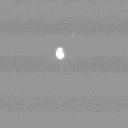Semi-major axis 212,280 ± 5 km Orbital period 28 hours | Eccentricity 0.0040 Discovered 1 June 2004 Discoverer Cassini Imaging Team | |
 | ||
Discovery date June 1, 2004 (second discovery by Cassini-Huygens) Inclination 0.1810 ± 0.0014° (to Saturn's equator) Similar Saturn moons, Other celestial objects | ||
Pallene (/pəˈliːniː/ pə-LEE-nee; Greek: Παλλήνη) is a very small natural satellite of Saturn. It is one of three small moons known as the Alkyonides that lie between the orbits of the larger Mimas and Enceladus. It is also designated as Saturn XXXIII (33).
Contents
Discovery
Pallene was discovered by the Cassini Imaging Team in 2004, during the Cassini–Huygens mission. It was given the temporary designation S/2004 S 2. In 2005, the name Pallene was provisionally approved by the IAU Division III Working Group for Planetary System Nomenclature, and was ratified at the IAU General Assembly in 2006. The name refers to Pallene, one of the Alkyonides, the seven beautiful daughters of the giant Alkyoneus.
After the discovery in 2004, it was realized that Pallene had been first photographed on August 23, 1981, by the space probe Voyager 2. It had appeared in a single photograph and had been provisionally named S/1981 S 14 and estimated to orbit 200,000 km from Saturn. Because it had not been visible in other images, it had not been possible to compute its orbit at the time, but recent comparisons have shown it to match Pallene's orbit.
Orbital characteristics
Pallene is visibly affected by a perturbing mean-longitude resonance with the much larger Enceladus, although this effect is not as large as Mimas's perturbations on Methone. The perturbations cause Pallene's osculating orbital elements to vary with an amplitude of about 4 km in semi-major axis, and 0.02° in longitude (corresponding to about 75 km). Eccentricity also changes on various timescales between 0.002 and 0.006, and inclination between about 0.178° and 0.184°.
Ring
In 2006, images taken in forward-scattered light by the Cassini spacecraft enabled the Cassini Imaging Team to discover a faint dust ring around Saturn that shares Pallene's orbit, now named the Pallene Ring. The ring has a radial extent of about 2,500 km. Its source is particles blasted off Pallene's surface by meteoroid impacts, which then form a diffuse ring around its orbital path.
Exploration
The Cassini spacecraft, which is currently studying Saturn and its moons, performed a fly-by of Pallene on 16 October 2010, at a distance of 36,000 kilometeres (22,000 miles).
